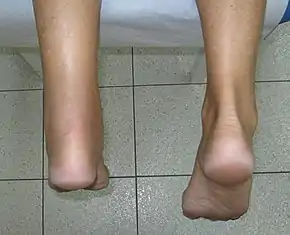Thompson test
The Thompson test (also called Simmonds' test or Simmonds-Thompson test) is used in lower limb examination to test for the rupture of the Achilles tendon.[1][2] The patient lies face down with feet hanging off the edge of the bed. If the test is positive, there is no movement of the foot (normally plantarflexion) on squeezing the corresponding calf, signifying likely rupture of the Achilles tendon.[3]
| Thompson test | |
|---|---|
 Left Achilles tendon rupture | |
| Synonyms | Simmonds' test Simmonds-Thompson test |
Interpretation of results
Recent research has indicated that while the test is an accurate detector of achilles rupture, it is unable to distinguish between partial tear (tear of the gastrocnemius or soleal portion only) and a complete tear of both portions. [4]
History
The test is named after Franklin Adin Simmonds (1911-1983), an English orthopaedic surgeon at the Rowley Bristow Hospital, Surrey.[5]
References
- Thompson TC (1962). "A Test for Rupture of the Tendo Achillis". Acta Orthopaedica Scandinavica. 32 (1–4): 461–465. doi:10.3109/17453676208989608. PMID 13981206.
- Thompson TC, Doherty JH (1962). "Spontaneous Rupture of Tendon of Achilles". The Journal of Trauma: Injury, Infection, and Critical Care. 2 (2): 126–129. doi:10.1097/00005373-196203000-00003. PMID 13920945.
- Scott BW, Al Chalabi A (1992). "How the Simmonds-Thompson test works". The Journal of Bone and Joint Surgery. British Volume. 74 (2): 314–5. doi:10.1302/0301-620X.74B2.1544978. PMID 1544978.
- Douglas J, Kelly M, Blachut P (2009). "Clarification of the Simmonds–Thompson test for rupture of an Achilles tendon". Canadian Journal of Surgery. 52 (3): E40–E41. PMC 2689757. PMID 19503640.
- Simmonds FA (1957). "The diagnosis of the ruptured Achilles tendon". The Practitioner. 179 (1069): 56–8. PMID 13453094.